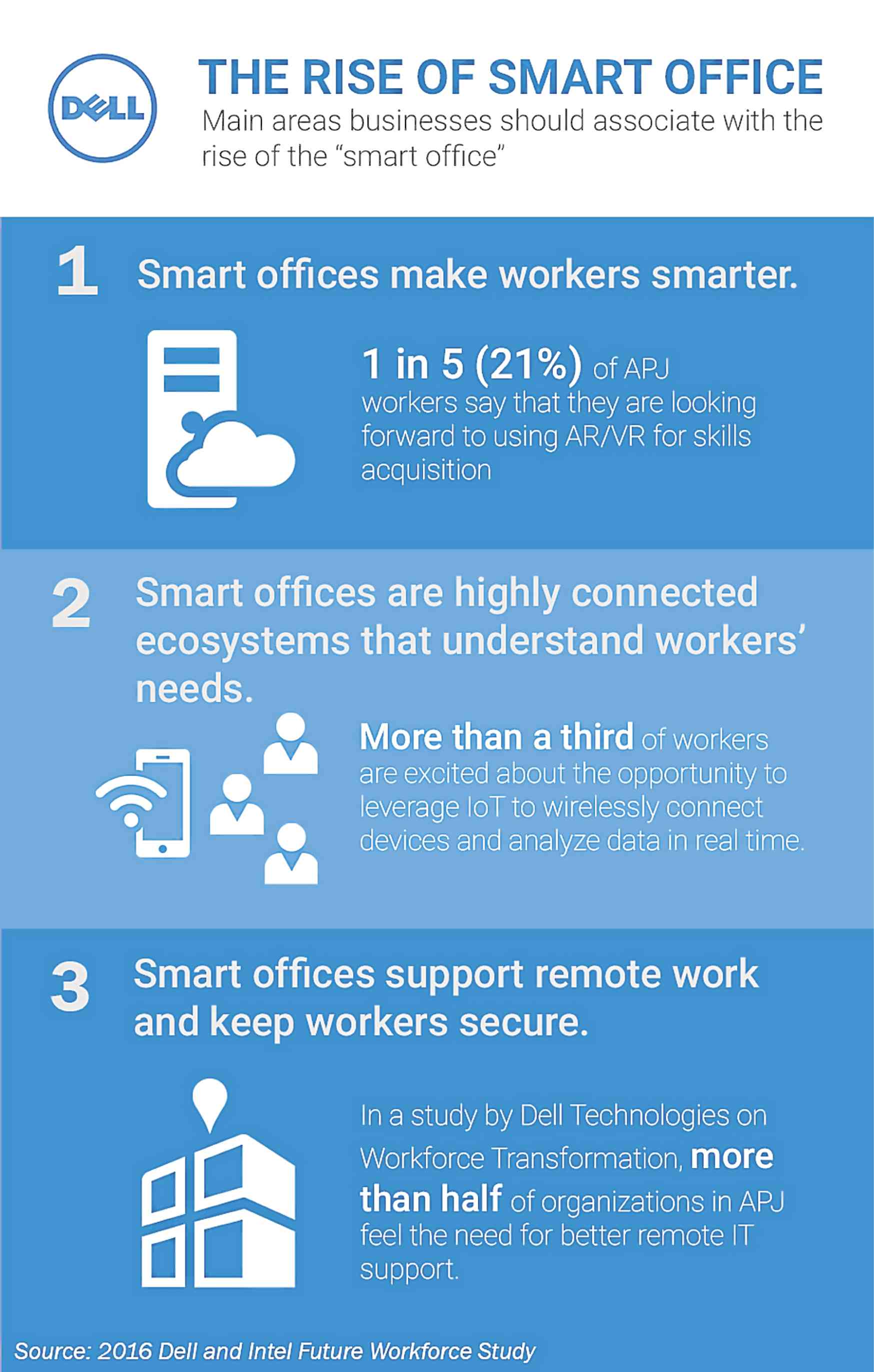How do you picture the workplace 20 years from now? Do offices still exist, or have we completely traded in headquarters for personal quarters? Is the workforce more collaborative or more siloed? More productive or distracted? Is it even human?
According to the 2016 Dell and Intel Future Workforce Study, nearly half of workers in Asia Pacific and Japan (APJ) (45 percent) said they expected to be working in a smart office offering Internet of Things and other technologies in the next five years. It’s clear that while the coming wave of technology, particularly artificial intelligence, does cause some apprehension among workers, it turns out most people are eagerly waiting for tech to take on a larger role in the workplace.
In the Philippines, there is already a growing clamor for telecommuting and remote working.
Telecommuting, as defined in Senate Bill No. 1363, or the Telecommuting Act of 2017, is the partial or total substitution of computers or telecommunication technologies for the commute to work by employees. The Senate recently passed this bill on its final reading. The act aims to encourage companies to establish or adopt work from home programs, as a mean to ease the worsening traffic congestion in urban areas, especially Metro Manila.
Consequently, this creates big opportunities for smart offices to flourish in the Philippines, enabling workers to work anywhere, becoming more agile and productive at their own pace. For this to work, smart technology or smart offices that extend beyond the office walls will become vital to both companies and the workers. Filipino employees would expect better technology to enable them anytime and anywhere and looking at all of the rapid developments happening in the country, and the region, their demand will only increase in the coming years.
There’s no doubt these worker expectations are going to catch many companies off guard.
Substandard tech
The Future Workforce Study revealed 42 percent of millennials in APJ said they’d be willing to leave a job over substandard tech—that means organizations in the Philippines would need to be cautious too. Thus, today’s companies have two options that might feel ironic in light of workers’ AI-related fears—provide a smart office or risk losing your top talent.
What exactly is a smart office?
There are several main areas businesses should associate with the rise of the “smart office,” in particular:
1. Smart offices make workers smarter.
While it’s true that some workers (23 percent) are afraid they’ll either be replaced by AI or become reliant on it, one in five (21 percent) of APJ respondents says that he/she is looking forward to using augmented/virtual reality for skills acquisition, and the same number (21 percent) say 3D visualization via AR/VR can help them come up with new ideas or solve existing problems.
For example, Upskill (APX Labs) develops wearable software technology that workers can use to get heads-up instructions, instant validation of their actions and other time-saving data interaction capabilities as they work.
The majority of APJ respondents also agreed that AI can make work easier, while IoT predictive maintenance solutions can address operational challenges such as unplanned downtime, overall equipment effectiveness and return on assets. This is a call for the IT department to explore technology that will help workers focus on value-add work rather than administrative within every department.
Workers’ needs
2. Smart offices are highly connected ecosystems that understand workers’ needs.
More than a third of workers are excited about the opportunity to leverage IoT to wirelessly connect devices and analyze data in real time. Another innovative company Comfy is using IoT to connect employees directly to their companies’ HVAC systems, enabling workers to “vote” on the temperature settings for their area of the building. The idea of using IoT to customize workspaces to personal preferences is an exciting prospect for many and could help reduce energy consumption for businesses as well.
3. Smart offices support remote work.
In another study by Dell Technologies on Workforce Transformation, more than half of organizations in APJ feel the need for better remote IT support. With more employees in the region looking to work from multiple locations and using several different devices, seamless and secure file sharing and collaboration capabilities will supplant the need for face-to-face communications in the future.
4. Smart offices keep workers secure.
The increasing demand for multiple employee devices is becoming a major security headache for two thirds (71 percent) of APJ organizations. The recent ransomware attacks such as WannaCry clearly indicate that endpoint devices are the weakest link in an organization’s network. With the usage of latest devices featuring more advanced security technology, one can ensure enhanced security for employees, without hampering their productivity.
But here’s the catch—even with all this technology on the horizon, workers say the biggest thing companies can do to improve their productivity is to just make sure the technology offered works efficiently. Top time wasters during work include slow or glitchy software programs and devices, beating out meetings and water cooler conversations.
It’s clear that employee experience is intrinsically related to their expectations of a smart office and central to the bottom line for any organization. So, make sure you’re providing reliable software and devices to enable, rather than hinder workers whether they’re in the office or working remotely. Then, develop a long-term resource investment plan that recognizes technology and talent retention are no longer separate line items.
If you want to get the best performance out of the best workers, invest in productivity-enabling tech.


